腾讯课堂 | Python网络爬虫与文本分析
TidyTextPy
前天我分享了 tidytext | 耳目一新的R-style文本分析库
但是tidytext不够完善,我在tidytext基础上增加了情感词典,可以进行情感计算,为了区别前者,将其命名为tidytextpy。
大家有时间又有兴趣,可以多接触下R语言,在文本分析及可视化方面,R的能力也不弱。
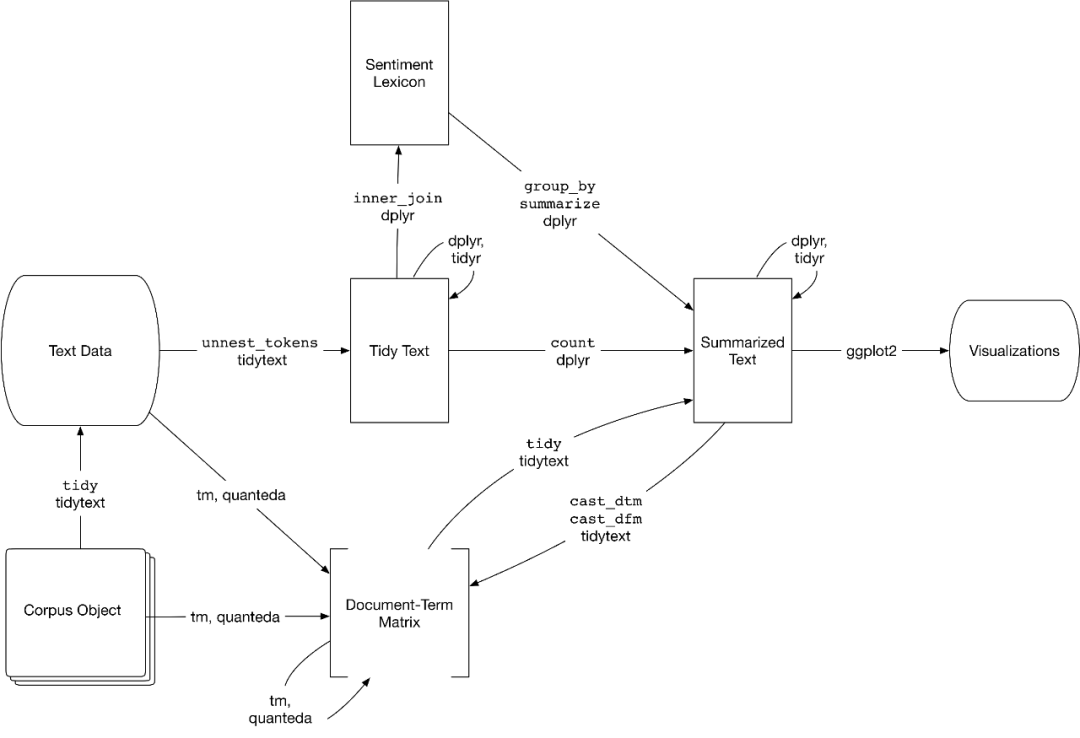
安装
pip install tidytextpy
实验数据
这里使用中文科幻小说《三体》为例子,含注释共213章,使用正则表达式构建三体小说数据集,该数据集涵
- chapterid 第几章
- title 章(节)标题
- text 每章节的文本内容(分词后以空格间隔的文本,形态类似英文)
import pandas as pd
import jieba
import re
pd.set_option('display.max_rows', 6)
raw_texts = open('三体.txt', encoding='utf-8').read()
texts = re.split('第\d+章', raw_texts)
texts = [text for text in texts if text]
#中文多了下面一行代码(构造用空格间隔的字符串)
texts = [' '.join(jieba.lcut(text)) for text in texts if text]
titles = re.findall('第\d+章 (.*?)\n', raw_texts)
data = {'chapterid': list(range(1, len(titles)+1)),
'title': titles,
'text': texts}
df = pd.DataFrame(data)
df
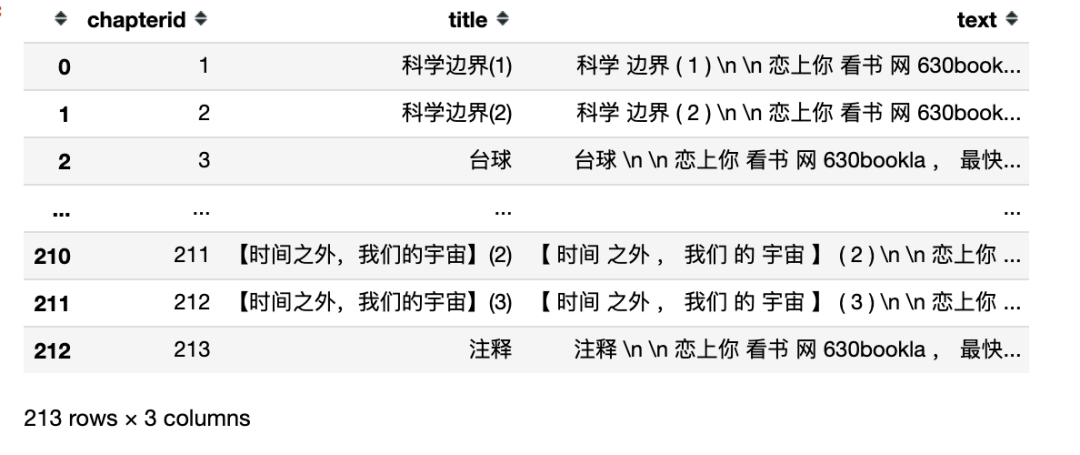

tidytextpy库
- get_stopwords 停用词表
- get_sentiments 情感词典
- unnest_tokens 分词函数
- bind_tf_idf 计算tf-idf
停用词表
get_stopwords(language) 获取对应语言的停用词表,目前仅支持chinese和english两种语言
from tidytextpy import get_stopwords
cn_stps = get_stopwords('chinese')
#前20个中文的停用词
cn_stps[:20]
['、',
'。',
'〈',
'〉',
'《',
'》',
'一',
'一些',
'一何',
'一切',
'一则',
'一方面',
'一旦',
'一来',
'一样',
'一般',
'一转眼',
'七',
'万一',
'三']
en_stps = get_stopwords()
#前20个英文文的停用词
en_stps[:20]
['i',
'me',
'my',
'myself',
'we',
'our',
'ours',
'ourselves',
'you',
'your',
'yours',
'yourself',
'yourselves',
'he',
'him',
'his',
'himself',
'she',
'her',
'hers']
情感词典
get_sentiments('词典名') 调用词典,返回词典的dataframe数据。
- afinn sentiment取值-5到5
- bing sentiment取值为positive或negative
- nrc sentiment取值为positive或negative,及细粒度的情绪分类信息
- dutir sentiment为中文七种情绪类别(细粒度情绪分类信息)
- hownet sentiment为positive或negative
其中hownet和dutir为中文情感词典
from tidytextpy import get_sentiments
#大连理工大学情感本体库,共七种情绪(sentiment)
get_sentiments('dutir')
| sentiment | word | |
|---|---|---|
| 0 | 惊 | 冷不防 |
| 1 | 惊 | 惊动 |
| 2 | 惊 | 珍闻 |
| ... | ... | ... |
| 27411 | 惧 | 匆猝 |
| 27412 | 惧 | 忧心仲忡 |
| 27413 | 惧 | 面面厮觑 |
27414 rows × 2 columns
get_sentiments('nrc')
| word | sentiment | |
|---|---|---|
| 0 | abacus | trust |
| 1 | abandon | fear |
| 2 | abandon | negative |
| ... | ... | ... |
| 13898 | zest | positive |
| 13899 | zest | trust |
| 13900 | zip | negative |
13901 rows × 2 columns
分词
unnest_tokens(__data, output, input)
__data待处理的dataframe数据- output 新生成的dataframe中,用于存储分词结果的字段名
- input 待分词数据的字段名(待处理的dataframe数据)
from tidytextpy import unnest_tokens
tokens = unnest_tokens(df, output='word', input='text')
tokens
| chapterid | title | word | |
|---|---|---|---|
| 0 | 1 | 科学边界(1) | 科学 |
| 0 | 1 | 科学边界(1) | 边界 |
| 0 | 1 | 科学边界(1) | 1 |
| ... | ... | ... | ... |
| 212 | 213 | 注释 | 想到 |
| 212 | 213 | 注释 | 暗物质 |
| 212 | 213 | 注释 | 。 |
556595 rows × 3 columns
各章节用词量
从这里开始会用到plydata的管道符>> 和相关的常用函数,建议大家遇到不懂的地方查阅plydata文档
from plydata import count, group_by, ungroup
wordfreq = (df
>> unnest_tokens(output='word', input='text') #分词
>> group_by('chapterid') #按章节分组
>> count() #对每章用词量进行统计
>> ungroup() #去除分组
)
wordfreq
| chapterid | n | |
|---|---|---|
| 0 | 1 | 2549 |
| 1 | 2 | 2666 |
| 2 | 3 | 1726 |
| ... | ... | ... |
| 210 | 211 | 2505 |
| 211 | 212 | 2646 |
| 212 | 213 | 2477 |
213 rows × 2 columns
章节用词量可视化
使用plotnine进行可视化
from plotnine import ggplot, aes, theme, geom_line, labs, theme, element_text
from plotnine.options import figure_size
(ggplot(wordfreq, aes(x='chapterid', y='n'))+
geom_line()+
labs(title='三体章节用词量折线图',
x='章节',
y='用词量')+
theme(figure_size=(12, 8),
title=element_text(family='Kai', size=15),
axis_text_x=element_text(family='Kai'),
axis_text_y=element_text(family='Kai'))
)
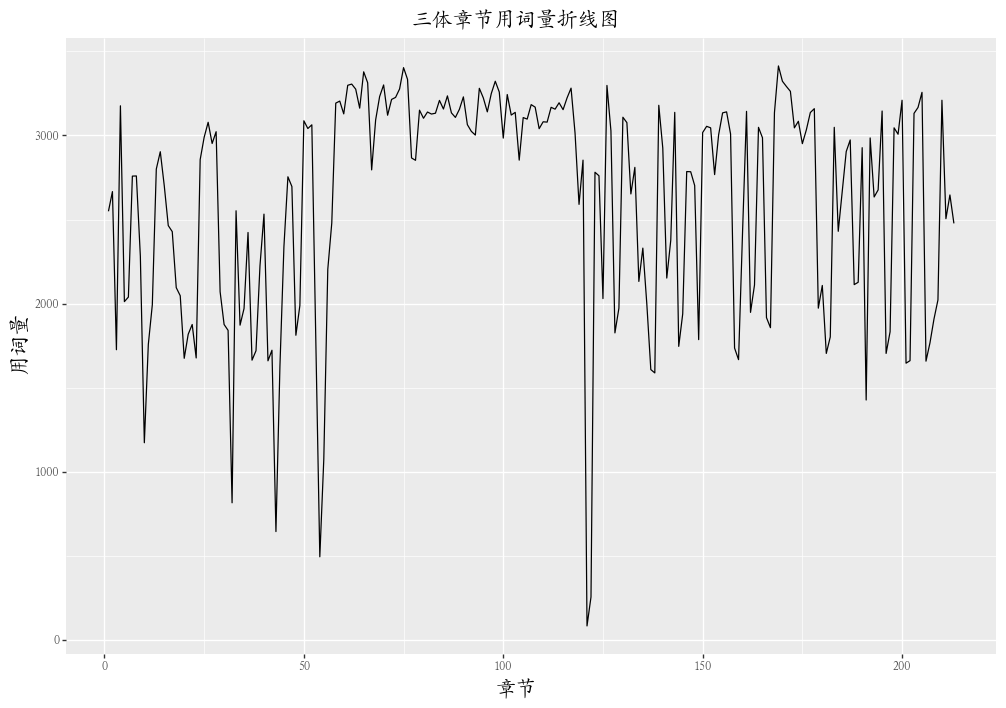
情感分析
重要的事情多重复一遍o( ̄︶ ̄)o
get_sentiments('词典名') 调用词典,返回词典的dataframe数据。
- afinn sentiment取值-5到5
- bing sentiment取值为positive或negative
- nrc sentiment取值为positive或negative,及细粒度的情绪分类信息
- dutir sentiment为中文七种情绪类别(细粒度情绪分类信息)
- hownet sentiment为positive或negative
其中hownet和dutir为中文情感词典
情感计算
这里会用到plydata的很多知识点,大家可以查看https://plydata.readthedocs.io/en/latest/index.html 相关函数的文档。
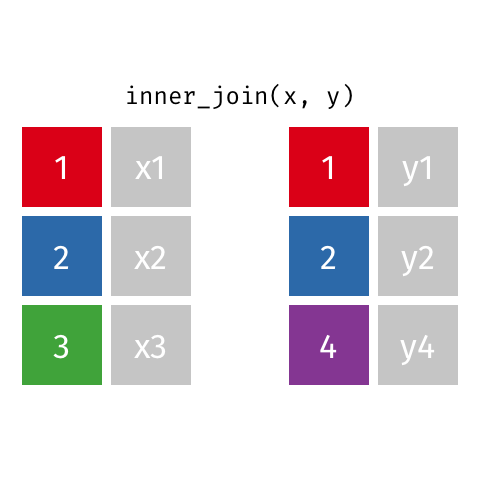
from plydata import inner_join, count, define, call
from plydata.tidy import spread
chapter_sentiment_score = (
df #分词
>> unnest_tokens(output='word', input='text')
>> inner_join(get_sentiments('hownet')) #让分词结果与hownet词表交集,给每个词分配sentiment
>> count('chapterid', 'sentiment')#统计每章中每类sentiment的个数
>> spread('sentiment', 'n') #将sentiment中的positive和negative转化为两列
>> call('.fillna', 0) #将缺失值替换为0
>> define(score = '(positive-negative)/(positive+negative)') #计算每一章的情感分score
)
chapter_sentiment_score
| chapterid | negative | positive | score | |
|---|---|---|---|---|
| 0 | 1 | 93.0 | 56.0 | -0.248322 |
| 1 | 2 | 98.0 | 83.0 | -0.082873 |
| 2 | 3 | 54.0 | 37.0 | -0.186813 |
| ... | ... | ... | ... | ... |
| 210 | 211 | 56.0 | 73.0 | 0.131783 |
| 211 | 212 | 71.0 | 67.0 | -0.028986 |
| 212 | 213 | 75.0 | 74.0 | -0.006711 |
213 rows × 4 columns
三体小说情感走势
我记得看完《三体》后,很悲观,觉得人类似乎永远逃不过宇宙的时空规律,心情十分压抑。如果对照小说进行章节的情感分析,应该整体情感分的走势大多在0以下。
from plotnine import ggplot, aes, geom_line, element_text, labs, theme
(ggplot(chapter_sentiment_score, aes('chapterid', 'score'))+
geom_line()+
labs(x='章节', y='情感值score', title='《三体》小说情感走势图')+
theme(title=element_text(family='Kai'))
)
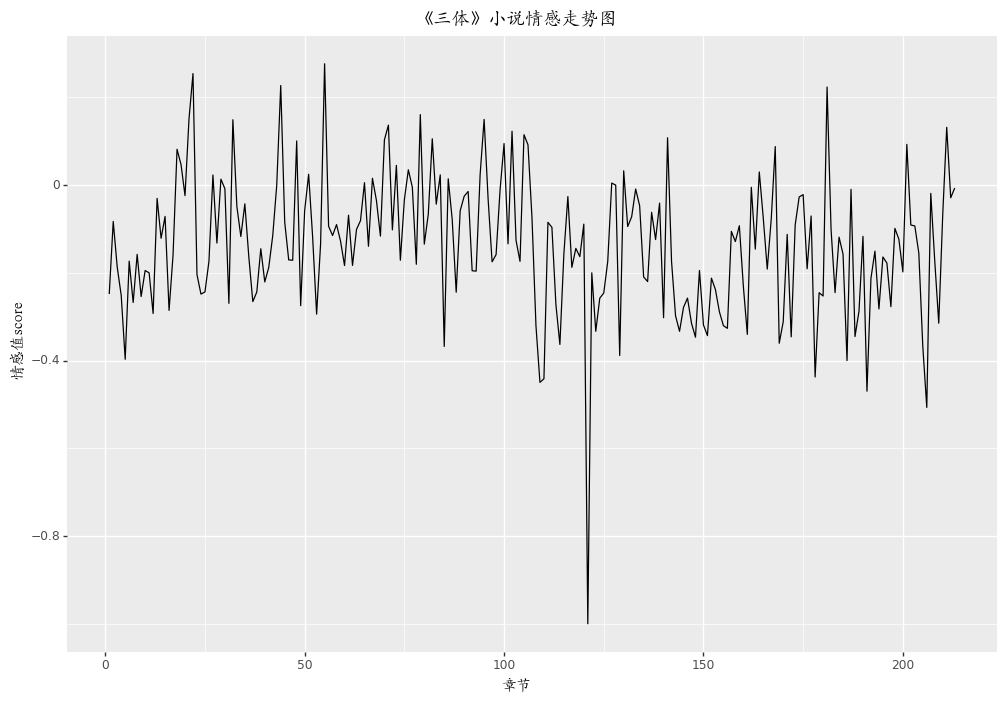
tf-idf
相比之前的代码,bind_tf_idf运行起来很慢很慢,《三体》数据量大,所以这里用别的数据做实验。
tf-idf实验数据
import pandas as pd
pd.set_option('display.max_rows', 6)
zen = """
The Zen of Python, by Tim Peters
Beautiful is better than ugly.
Explicit is better than implicit.
Simple is better than complex.
Complex is better than complicated.
Flat is better than nested.
Sparse is better than dense.
Readability counts.
Special cases aren't special enough to break the rules.
Although practicality beats purity.
Errors should never pass silently.
Unless explicitly silenced.
In the face of ambiguity, refuse the temptation to guess.
There should be one-- and preferably only one --obvious way to do it.
Although that way may not be obvious at first unless you're Dutch.
Now is better than never.
Although never is often better than *right* now.
If the implementation is hard to explain, it's a bad idea.
If the implementation is easy to explain, it may be a good idea.
Namespaces are one honking great idea -- let's do more of those!
"""
zen_split = zen.splitlines()
df = pd.DataFrame({'docid': list(range(len(zen_split))),
'text': zen_split})
df
| docid | text | |
|---|---|---|
| 0 | 0 | |
| 1 | 1 | The Zen of Python, by Tim Peters |
| 2 | 2 | |
| ... | ... | ... |
| 19 | 19 | If the implementation is hard to explain, it's... |
| 20 | 20 | If the implementation is easy to explain, it m... |
| 21 | 21 | Namespaces are one honking great idea -- let's... |
22 rows × 2 columns
bind_tf_idf
tf表示词频,idf表示词语在文本中的稀缺性,两者的结合体现了一个词的信息量。找出小说中tf-idf最大的词。
bind_tf_idf(_data, term, document, n)
_data传入的df- term df中词语对应的字段名
- document df中文档id的字段名
- n df中词频数对应的字段名
from tidytextpy import bind_tf_idf
from plydata import count, group_by, ungroup
tfidfs = (df
>> unnest_tokens(output='word', input='text')
>> count('docid', 'word')
>> bind_tf_idf(term='word', document='docid', n='n')
)
tfidfs
| docid | word | n | tf | idf | tf_idf | |
|---|---|---|---|---|---|---|
| 0 | 1 | the | 1 | 0.142857 | 1.386294 | 0.198042 |
| 1 | 1 | zen | 1 | 0.142857 | 2.995732 | 0.427962 |
| 2 | 1 | of | 1 | 0.142857 | 1.897120 | 0.271017 |
| ... | ... | ... | ... | ... | ... | ... |
| 137 | 21 | more | 1 | 0.090909 | 2.995732 | 0.272339 |
| 138 | 21 | of | 1 | 0.090909 | 1.897120 | 0.172465 |
| 139 | 21 | those | 1 | 0.090909 | 2.995732 | 0.272339 |
140 rows × 6 columns
近期文章
[更新] Python网络爬虫与文本数据分析 tidytext | 耳目一新的R-style文本分析库rpy2库 | 在jupyter中调用R语言代码plydata库 | 数据操作管道操作符>>plotnine: Python版的ggplot2作图库七夕礼物 | 全网最火的钉子绕线图制作教程读完本文你就了解什么是文本分析文本分析在经管领域中的应用概述 综述:文本分析在市场营销研究中的应用plotnine: Python版的ggplot2作图库小案例: Pandas的apply方法 stylecloud:简洁易用的词云库 用Python绘制近20年地方财政收入变迁史视频 Wow~70G上市公司定期报告数据集漂亮~pandas可以无缝衔接Bokeh YelpDaset: 酒店管理类数据集10+G 后台回复关键词【20200822】获取本文代码








)




)
 。_学小易找答案...)



